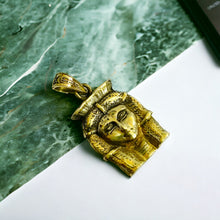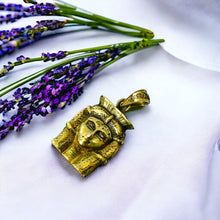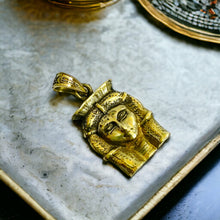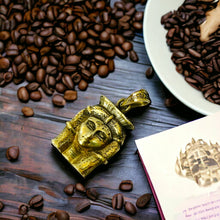
The Goddess Hathor Gold Pendant Necklace combines ancient Egyptian mythology with modern elegance. Inspired by Hathor, the goddess of love and joy, worshipped for millennia along the Nile, this pendant symbolizes beauty and divine grace in timeless gold craftsmanship.
- History: Inspired by Goddess Hathor, ancient Egyptian deity of love, joy, and motherhood.
- Spirituality: Represents divine feminine energy, nurturing, and abundance.
- Talisman: Believed to bring love, prosperity, and protection to the wearer.
- Handmade: Crafted with care using traditional techniques for authenticity.
- Healing: Thought to promote emotional healing and spiritual growth.
- Material: Pure gold, symbolizing purity, strength, and luxury.
- Symbolism: Lotus symbol for rebirth; cow horns for nurturing and fertility.
- How to Wear: Perfect for any chain up to 5mm, versatile and elegant.
History Side For Those Who Are Interested
Hathor, one of ancient Egypt's most significant goddesses, played a multifaceted role throughout Egyptian history, spanning millennia from the Old Kingdom to the Greco-Roman period. Her origins are believed to trace back to prehistoric times, evolving and assimilating various aspects as Egyptian civilization developed.
-
Ancient Origins and Identity: Hathor originally emerged as a sky goddess associated with fertility, motherhood, and love. She was often depicted as a cow or with cow horns, symbolizing maternal nurturing and abundance. Over time, Hathor's identity expanded to include roles as a goddess of music, dance, joy, and the afterlife.
-
Cult Centers: Hathor was revered throughout Egypt, with major cult centers in Dendera, Thebes (modern-day Luxor), Memphis, and Sinai. Each cult center contributed to different aspects of her character, such as Dendera focusing on her role as a sky goddess and Thebes emphasizing her association with the royal court and the afterlife.
-
Mythological Significance: In Egyptian mythology, Hathor played a crucial role in the journey of the sun god Ra. She was sometimes depicted as the "Eye of Ra," a protective and vengeful aspect defending Ra against his enemies. Hathor also accompanied Ra on his daily journey through the sky, providing light and warmth to the world.
-
Associations and Symbols: Hathor was symbolized by the sistrum (a musical instrument), the menat (a ritual necklace), and the ankh (symbol of life). These symbols underscored her connection to music, dance, and the perpetuation of life.
-
Cultural Integration and Influence: Hathor's worship extended beyond Egypt's borders, influencing neighboring cultures such as the ancient Greeks who identified her with their goddess Aphrodite. This syncretism reflected Hathor's enduring appeal and adaptability.
-
Evolution in Art and Representation: Hathor's depiction evolved over time, ranging from the early cow-headed form to more anthropomorphic representations with a human face and the horns and sun disk headdress. She was often depicted with a gentle demeanor and a welcoming posture, reflecting her role as a nurturing and benevolent deity.
-
Enduring Legacy: Hathor's legacy persisted into the Roman period, where she continued to be worshipped and honored in Egypt and beyond. Temples dedicated to Hathor were centers of music, dance, and healing rituals, demonstrating her enduring cultural significance.
Overall, Hathor's history exemplifies the rich complexity of ancient Egyptian religion and its ability to evolve while maintaining core themes of fertility, motherhood, joy, and divine protection. Her multifaceted nature ensured her enduring popularity throughout Egypt's long and storied history.



























